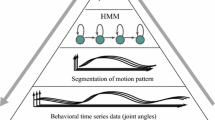Abstract
Sentence-final particles serve an important role in spoken Japanese, because they express the speaker’s mental attitudes toward a proposition and/or an interlocutor. They are acquired at early ages and occur very frequently in everyday conversation. However, there has been little proposal for a computational model of the acquisition of sentence-final particles. In this paper, we report on a study in which a robot learns how to react to utterances that have a sentence-final particle and gives appropriate responses based on rewards given by an interlocutor, and at the same time, learns the meaning of nouns. Preliminary experimental result shows that the robot learns to react correctly in response to yo, which expresses the speaker’s intention to communicate new information, and to ne, which denotes the speaker’s desire to confirm that some information is shared, and also learns the correct referents of nouns.
Access this chapter
Tax calculation will be finalised at checkout
Purchases are for personal use only
Preview
Unable to display preview. Download preview PDF.
Similar content being viewed by others
References
Alishahi, A.: Computational Modeling of Human Language Acquisition, Morgan & Claypool (2010)
Kinsui, S.: Latest information on Linguistics: Japanese language study: Sentence-final particles yo and ne. Gengo 22(4), 118–121 (1993) (in Japanese )
Ogami, R., Matsuoka, H., Araki, O., Shibata, R., Takaoka, Y., Tsuchisaka, Y., Wu, X., Fukada, C., Ozeki, M., Oka, N.: Meaning acquisition of function words through human-robot interaction: Viewing the meaning of sentence-final particles as appropriate actions for utterances. Paper Presented at Human-Agent Interaction Symposium 2012, 2D-7 (2012) (in Japanese)
Ohshima, N., Ohyama, Y., Odahara, Y., De Silva, P.R.S., Okada, M.: Talking-ally: Intended persuasiveness by the utilizing hearership and addressivity. In: Proceedings of the Fourth International Conference on Social Robotics, pp. 317–326 (2012)
Oka, N., Ogami, R., Wu, X., Fukada, C., Ozeki, M.: Acquiring the meaning of sentence-final particles yo and ne through human-robot interaction. Paper Presented at the First International Conference on Human-Agent Interaction, Sapporo, Japan (2013)
Sutton, R.S., Barto, A.G.: Reinforcement learning: An introduction. MIT Press, Cambridge (1998)
Author information
Authors and Affiliations
Editor information
Editors and Affiliations
Rights and permissions
Copyright information
© 2013 Springer-Verlag Berlin Heidelberg
About this paper
Cite this paper
Oka, N., Wu, X., Fukada, C., Ozeki, M. (2013). Concurrent Acquisition of the Meaning of Sentence-Final Particles and Nouns Through Human-Robot Interaction. In: Lee, M., Hirose, A., Hou, ZG., Kil, R.M. (eds) Neural Information Processing. ICONIP 2013. Lecture Notes in Computer Science, vol 8226. Springer, Berlin, Heidelberg. https://doi.org/10.1007/978-3-642-42054-2_48
Download citation
DOI: https://doi.org/10.1007/978-3-642-42054-2_48
Publisher Name: Springer, Berlin, Heidelberg
Print ISBN: 978-3-642-42053-5
Online ISBN: 978-3-642-42054-2
eBook Packages: Computer ScienceComputer Science (R0)




